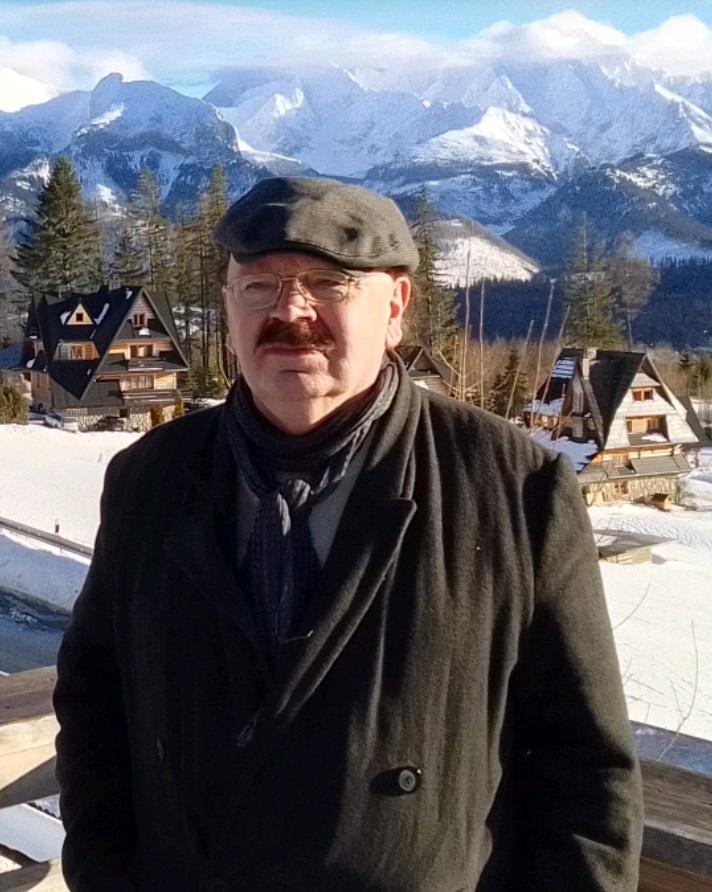
photo: private archive
Traditions of folk caroling – interview with prof. Zbigniew J. Przerembski
Although the Christmas holidays are over, we are still in the Christmas caroling season. According to prof. Zbigniew J. Przerembski: According to prof. Zbigniew J. Przerembski: “The word: carol and carol singing have different meanings in our country, related to the Christian religion or folk culture – it is a song, a gift, a Christmas visit of a priest to parishioners’ houses, rituals of the ritual cycle of the (annual) calendar.” Contemporary carol singing at the Christmas table differs significantly from the folk carol singing of a few hundred years ago, with traditions dating back to pagan times.
What musical customs and traditions have developed in folk culture over the centuries? When and how long did the caroling last? How did the carolers make their wishes known to the household? Whatdid people do to oppose devilsand other evil spirits? What are anti-music and anti-instruments in the cultural tradition of the Polish lands? We invite you to read an interview with prof. Zbigniew J. Przerembski of the Institute of Musicology at the University of Wrocław.
Maria Kozan: What caroling was like in Polish villages at the turn of the 19th/20th century?
Prof. Zbigniew J. Przerembski: The word: carol and carol singing have different meanings in our country, related to the Christian religion or folk culture – it is a song, a gift, a Christmas visit of a priest to parishioners’ houses, rituals of the ritual cycle of the (annual) calendar. Focusing here on folk culture, the traditions of caroling go back to pagan times. It was held during the winter solstice, called mating season by the Slavs (and still our ancestors), which overlapped with the Christmas season (there were also Easter carols). The ceremonial year and the church year begin with Advent. At that time, caroling was already beginning in some regions (such as Kashubia). There are many types and forms of caroling, in which folk elements, with roots still pagan, intermingle with Christian ones. The carolers walked with animal mascots, with a star, with a nativity scene, and presented mysteries, such as herodas and nativity plays.
MK: Why does caroling take place at the turn of the old year and the new year?
ZP: It used to be believed that the turn of the old year and the new year is a time of transition, dangerous for human. When December came, people were gripped by anxiety, they were unsure if the New Year would come at all. Why? In traditional culture, it was believed that generally nothing just happens on its own – everything has to be solicited, through various types of prayers in the Christian and even pre-Christian, ritual sense. People strived to make reality work for them. It was believed that there were various evil metaphysical entities around, in the form of devils in Christian beliefs and pagan demons that sought to do harm. These dastardly powers wanted to prevent the arrival of the new year, resulting in a continuous winter, no spring and no vegetation cycle, and therefore no crops.
MK: What did people do to oppose devils and other evil spirits?
ZP: Demons, as it was believed, hate noise, so ritual uproar was made. Contemporarily, champagne corks pop at midnight. And why don’t we open the wine? Why this bang? This is the remnant of the ritual uproar that was done at midnight on December 31 to chase away demons seeking to stop the change of the year from the old to the new. So champagne corks are firing, but there are also fireworks, firecrackers. Today the bangs are feared by animals, we don’t know if they are also feared by demons, but in the past it was believed that as a result of these acoustic activities, evil spirits would be chased away and a new year could dawn. Fireworks and firecrackers are now a spectacle, a joyous transition from the old to the new year. In the past, these sound apotropaic activities were a battle against the forces of darkness, which had to be dispelled.
MK: Was such uproar performed only once a year?
ZP: The presence of evil powers was also believed to be present during other rites of passage, not only in the annual cycle, but also in the family cycle, such as during weddings and wedding receptions, when people transitioned from an unmarried to a married status. Demons were then ready to harm newlyweds and wedding guests, so ritual uproar was made, such as on the way to the wedding, to the church, and back, to the wedding house (inn). Even today, a tin is attached to the car in which the newlyweds drive and which clatters as it hits the pavement. It is not used to keep people looking at what a beautiful young couple, but precisely to keep the demons, avoiding noise, from entering the car. Another example is breaking glass on the doorstep of a wedding house to prevent evil spirits, shunned by sharp objects, from entering. In the past, much more bang was done at the time and places of the transition, and few such behaviors survive today as reminiscences of these ancient rituals.
MK: Back to caroling. Can we nowadays see what caroling used to be like in Polish villages?
ZP: First of all, during festivals or folklore competitions – I encourage you to go to Bukowina Tatrzanska, where from February 9 to 12, as part of the 51st Highland Carnival, the National Competition of Caroling Groups will be held, dedicated precisely to these ancient forms of caroling, in their regional diversity. In addition, in some regions carolers still visit rural homes.
MK: What did this traditional caroling look like in the Polish countryside?
ZP: As I mentioned, caroling is a time of transition characterized by a shift in reality, when everything is in reverse and we are suspended in time. The carolers were visitors “from another world,” from an unknown interior, dressed in various costumes with symbolic meanings. They used to be accompanied by live animals (also culturally significant), such as a horse or a chained bear, but later they dressed up as a bear, a turon, a goat, among others, which depended on the type of caroling and the region. They performed wishful carols, not talking about the baby Jesus, Mary, Joseph, although in later times pastorals were also sung, but with shepherds and Bethlehem transferred to local realities.
MK: Did women participate in caroling?
ZP: The carolers should be men. Even if there were “roles” for women in a particular form of caroling, men dressed up as them (e.g., as gypsies). Women did not carol due to the fact that it was associated with bad omens. On Christmas, when someone knocked on the house, they looked through the window, if by chance it was a woman. The first to come should be men, then women could come. But there have been exceptions – for example, in the villages of the Silesian Beskids, certain types of caroling involved girls, but also boys.
MK: In various regions of Poland was caroling a little different?
ZP: Just as folk music varies from one region of Poland to another, caroling went on somewhat variously in different parts of the country. Nevertheless, many manifestations of this ritual were common. Carolers visited homes, were anticipated and called canvassers of luck. For they came with an offer of good fortune in the form of wishes, and after all, it is said scholars, the word has the power to constitute the designator, as in the well-known carol: the word (of God) becomes flesh. In order for something to happen, it must be spoken, or better yet, sung, preferably by ceremonial people, at a ceremonial time, because it then has greater causal power.
MK: How did the carolers make their wishes known to the household?
ZP: According to the traditional order – they started with the host of the household, then wished the hostess, the boy, the girl. To each what he or she expected. In the case of the landlord, of course, crops and income were important. They wished that the coming year would bring a barn full of grain, that foals, calves and piglets would be born – in other words, prosperity in the field and homestead. Maidens were often wished to get married in the coming year. These were wishes addressed individually to each person, according to condition, gender, age. They usually took the form of a relatively long, linguistically colorful recitation, often singing – after all, not only St. Augustine believed that he who sings prays twice, so sung wishful carols were considered more effective.
MK: You mentioned demons. How were uninvited guests disposed of?
ZP: As caroling took place at the time of the transition, the turn of the old and new year, the presence of invisible demons was suspected in the house (inn or chamber) where the carolers entered. And why were they supposed to be there? In order to overhear what the carolers wished for and then counteract it, so that the wishes would not come true, i.e., for example, that the farmer would not have a good harvest and the maiden would not find a husband in the coming year. Accordingly, people have tried to resist the actions of evil, undesirable forces. At the time, so-called “anti-music” was performed and played on anti-instruments. Anti-music was characterized by dissonances, lack of melodic, harmonic, rhythmic order, while anti-instruments were musical instruments that produced noisy sounds instead of noble ones. It was a complete negation of musical beauty, even its opposite.
MK: What instruments were played at the time?
ZP: Such a typical instrument, so far preserved only in a few regions of Poland, is the so-called devil’s fiddle. It used to be a simple stick disguised as a violin, with the outline of its body cut out of a board, a cigar or tea box as a sound box, and a devil’s (less often human) head with ribbons and tin buzzers. Importantly, the strings were also not real, musical ones, but mostly just ordinary wires, out of tune. Another anti-instrument is the so-called burczybas, in the form of a small barrel made by cooper technique or made of a gouged tree trunk; over this a leather membrane, usually leather, was stretched from above, in the center of which, through a drilled hole, is threaded a bundle of horsehair. The caroler rubbed the bristles with damp palms or gloved hands rubbed with rosin, resulting in a low, burbling sound. Other anti-instruments were knockers, clappers, terkotki, and spawns. Anti-instruments were made from whatever was at hand. They were not supposed to make musical sounds, but only to make noise, to create a ceremonial uproar – so it was anti-music, without specific pitch or rhythmic values. It was with such props that carolers once visited homes, cleansed “acoustically” the place of demons and only, made wishes, having thanks to this procedure, as it was believed, a greater chance of coming true.
MK: Are these instruments still in use today?
ZP: Devil’s fiddles and burczybas are used by folk ensembles in Kashubia, Warmia and Mazury or Żywiec region. They are already made differently, with specially selected materials and attention to their aesthetic appearance. Musicians take to the stage largely to show the audience such strange instruments, and Kashubians additionally to manifest their regional identity. They also have percussion uses today – for rhythmic accompaniment to bands. Thus, their functions have changed – from apotropaic, anti-musical directed at demons to musical, intended for humans.
MK: Was caroling or is still caroling only on anti-instruments?
ZP: Of course not – carolers or accompanying musicians also play instruments, especially contemporary ones, sometimes ancient ones. A folk group called Pastuszkowi Grocze was formed in western Wielkopolska region (Greater Poland), whose members perform Christmas-time music on such instruments, among other things. In Poland (and Europe), the oldest instrument of complex construction is the bagpipes, whose history is at least a thousand years old. They appeared in the Middle Ages in Poland, the oldest surviving sources dating back to the 14th century. Such bagpipes, their largest type, the so-called koźle, as well as mazanki (a small 3-stringed fiddle instrument) are played by Pastuszkowi Grocze, “transporting” listeners to the Wielkopolska of old Polish times.
MK: How long did caroling last, and do they still carol in this way in Poland?
ZP: It varies, depending on the ingenuity of the carolers and the number of people to “surround” in the visited household. Sometimes carolers also came to neighboring villages. The tradition of caroling, often upheld by regionalists, is still preserved in the Beskid Żywiecki, to a greater or lesser extent somewhere in the Lublin region, Malopolska, Podkarpacie, Podhale, but also in Wielkopolska (Greater Poland, especially western) or Mazovia.
MK: How were the carolers thanked, were they given any donations?
ZP: Most often, the hosts gave them modest refreshments, Christmas baked goods, sometimes sausage, and less often small monetary donations.
MK: Thank you for the interview.
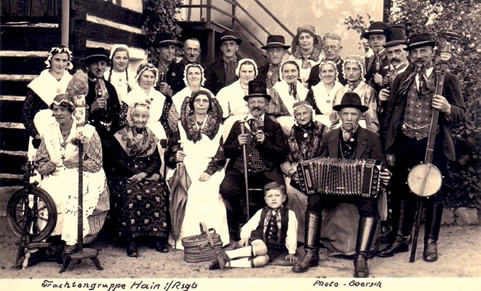
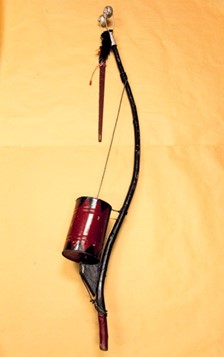

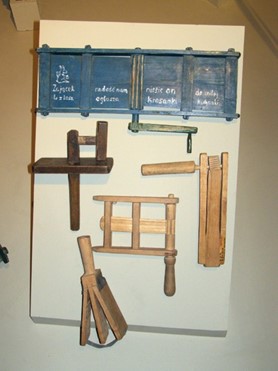
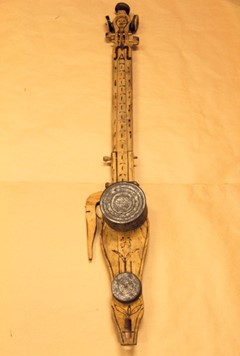

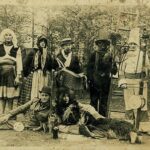
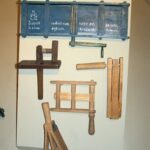


Illustrations are taken from an article by prof. Zbigniew J. Przerembski published in Tradycje śląskiej kultury muzycznej, tom XV pod red. A. Granat-Janki. Accessed online.



